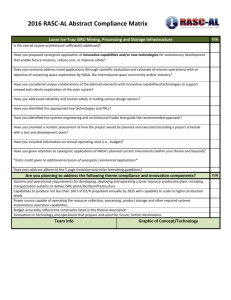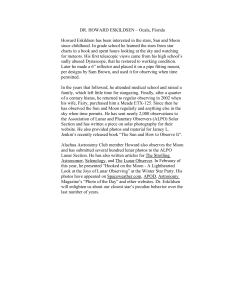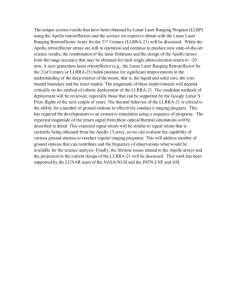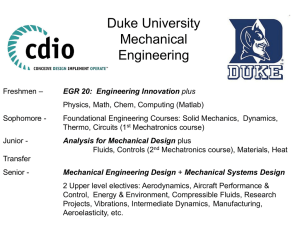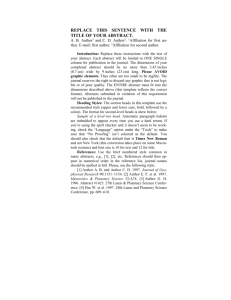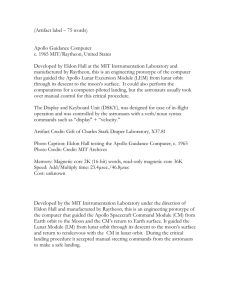Presentation of Handbook for Student Project Excavators
advertisement
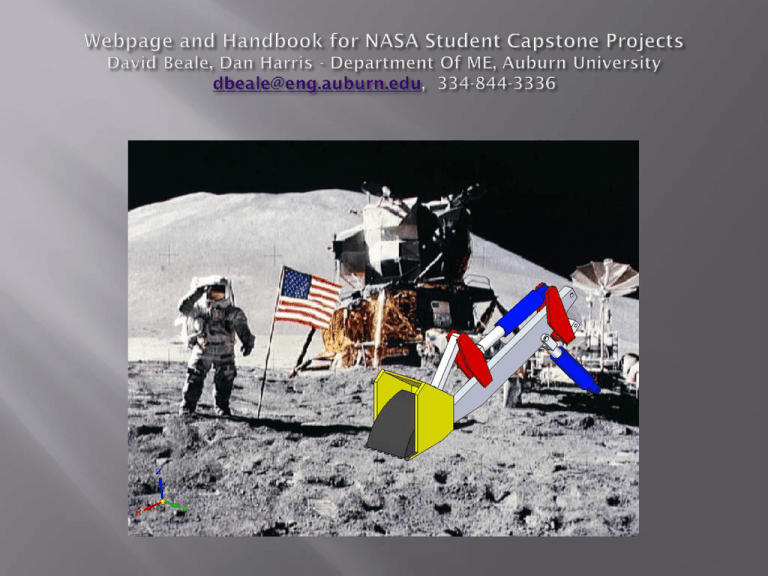
From ESMD site: “this project will investigate concepts for Lunar Regolith Excavation equipment and propose solutions in the form of completed designs and prototypes”, using a Systems Engineering Approach Topic: “Lunar Regolith Excavation for Oxygen Production and Outpost Emplacement” A standalone Systems Engineering Overview for Application of the Process on a Student Project Technical Contact and Monitor: Rob Mueller, Surface Systems Lead Engineer Don’t give students any design ideas – let their creative juices flow! I teach a senior project class (“capstone design”), working with a team of students assigned to a project. You could be AE, ME, EE, etc. Minimal or no lecturing – students spend their time on a project designing and building a prototype. Faculty guides the student team through the design process. Project could, but not necessarily, be multidisciplinary (single subsystem or many subsystems). So does this describe your situation?????? AND Are you interested in a NASA capstone design project??? NASA will support student teams with $7K through the Space Grant Consortium Pick a Project from the ESMD website; I chose the lunar excavator But students need some background information to proceed: Need to know about designing for the lunar environment (although they build a prototype for use on the earth) Need to know about Systems Engineering because NASA wants a Systems Engineering Approach What Resources are Available???? On Systems Engineering (SE): Provides background by a brief, but complete SE guidebook chapter (Chapter 3) for a student-team Systems Engineering Project. Student Friendly, with lots of examples and direction meant to simplify a complex process and APPLY IT. Faculty Friendly – faculty lectures for 2 weeks, and then guides the process per the process in the handbook and webpage (webpage is “stepby-step”). Co-authored by a NASA Systems Engineer. Strongly influenced by a special NASA SE course developed and tested at Univ of Texas Spring 08, by a NASA engineer with 20 years experience in SE. An application example project is presented in Chapter 4 on the CubeSat led by JM Wersinger On the Lunar Environment: Provides background on past and future lunar missions, lunar environment, materials and components, thermal control, CAE Made it “student friendly”. Cut through the clutter that SE literature is full of. A “linking webpage” – a chronology for the course, basis for the 2 weeks of lectures. Meant not to impede student design efforts with lots of lectures. Faculty should lecture about 2 weeks on SE, taking students through the webpage. Students read Chapter 3 (Systems Engineering) and CubeSat chapter. Quiz Students Thereafter faculty guides student team, who are referring back to the webpage for guidance. Webpage is a “Cliff Notes” format and project chronology, that links to the in-depth content of the following chapters: Chapter 1: Introduction Chapter 2: Systems Engineering Chapter 3: Systems Engineering Example of a Cubesat Chapter 4: Systems Engineering Tools Chapter 5: The Lunar Environment Chapter 6: Component Design and Selection Chapter 7: Thermal Control Chapter 8: CAE Tools Best reference: The “Lunar Sourcebook”, the book by Eckhart if you can find it. Review of the LPI website with the students. Objective: Provide background. Excite students. Students have little knowledge about what happened in early lunar missions, rovers are fun and legacy, neat lunar bases, teleoperated and autonomous “robonaut”, “chariot”. Best references: AU CubeSat Report, NASA SE Handbook as a reference, U of Texas Course notes. Systems Engineering literature is a mess, particularly if you want to apply it and learn it quickly. Complex and inconsistent terminology. Big questions: How to simplify SE, and apply on a student project? Sought help from experts who have applied it: Dick Cook, Lisa Guerra, Joe Bonometti, JM Wersinger It is possible to use these chapter for any SE student project!!! The Vee Chart: “Vee Chart” for the lifecycle, from –A through D The 11 SE functions: NASA Document GPG7120: Used this and description of 11 SE functions A Good Example: JM Wersinger’s student report that demonstrate SE tools, management structure, documentation, requirements, architecture, condensed in Chapter 3. Domain of Systems Engineering Domain of Engineering Design Pre-Phase A: Concept Studies Mission-Level Objectives + multiple R/A/C concepts + Mission Validation Plan Phase A: Concept Development Single System-level R/A/C + Trade Studies + System Verification Plan Phase D(4): SAITL System Demonstration and Validation Phase D(3): SAITL Integrate Subsystems and Verify System Performance Phase B: Preliminary Design Subsystem-level R/A/C + Interfacing + complete technology + Subsystems Verification Plan Phase D(2): SAITL Integrate Components and Verify Subsystem Performance Phase C(1): Final Design and Fabrication Final Detailed Design Phase D(1): SAITL Verify Component Performance Phase C(2): Final Design and Fabrication Fabric hardware and software Mission Requirements & Priorities System Demonstration & Validation Develop System Requirements & System Architecture Integrate System & Verify Performance Specs Allocate Performance Specs & Build Verification Plan Design Components Component Integration & Verification Verify Component Performance Fabricate, Assemble, Code & Procure Parts Systems Engineering Domain Component Engineering Domain Input: Mission Objectives (Starts PreValidate and Verify Phase A) Derived Requirements Architecture /Design Validate and Verify Other SE Functions: • Interfaces •Mission Environment •Resource Budgets •Risk Management •Configuration Management •Reviews Validate and Verify Concept of Operations Output: Proceed to next Phase, ending at Operations (Phase E) 1 The Lunar Environment and Issues for Engineering Design 1.1 Gravity and the Lunar Vacuum 1.2 The Lunar Day and Night 1.3 Radiation 1.3.1 Electromagnetic and Particle Radiation (Smithers, 2007; Tribble, 2003) 1.3.2 Ionizing Radiation 1.3.3 Radiation and Survivability 1.4 Surface Temperature 1.5 Micrometeoroids 1.6 Regolith 1.6.1 General Characteristics 1.6.2 Other Physical Properties 1.6.3 Chemistry 1.6.4 Geotechnical and Engineering properties 1.6.5 Regolith Simulants 1.7 Summary of Lunar Resources 1.8 APPENDIX – SOIL AND ROVER FORCE CALCULATIONS Best Reference: Conley (Satellites), Lunar Rover pages at LPI When designing the excavator, not much guidance is available in the literature for lunar components, so turned to space engineering literature that focused on satellites. The Lunar Rover represents legacy, students can view a successful lunar product I sent students out to do “trade studies”, looking at materials for a bit, conveyor belt, support structure, etc. Found and listed a number of standards Considered fasteners, bearings, motors, power components Modeling and simulating is often used in the design phases of Systems Engineering Demonstrated a multi-body dynamic simulation of a excavator using Dynamic Designer In response to and suggested by reviewer Rearrangement of order of topics to suit a course Content when needed in the course, based on SE approach and sequence of SE events as the course proceedes. Also a kind of “Cliff Notes” with links to content already in other chapters Follow the Process on the Webpage Pick a mission objective Get money in place from Space Grant Contact other faculty for multidisciplinary teams (although you can run just an ME team with the mechanical excavator missions objective) Design and build for one or two semesters, excavator to mate to KSC vehicle Test in bin full of dry concrete. Compete??? Send video to NASA+ report David Beale 334-844-3336 dbeale@eng.auburn.edu http://www.eng.auburn.edu/~dbeale/ESMDCourse/
